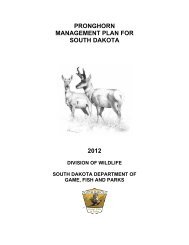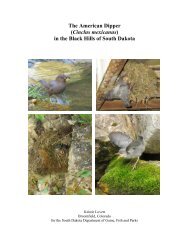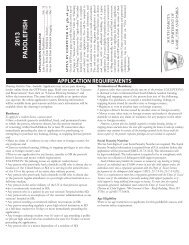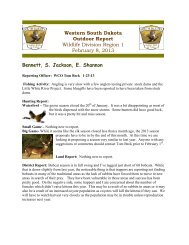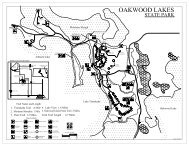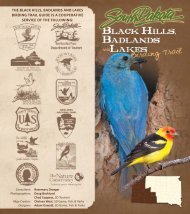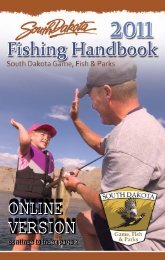pdf version - South Dakota Department of Game, Fish and Parks
pdf version - South Dakota Department of Game, Fish and Parks
pdf version - South Dakota Department of Game, Fish and Parks
Create successful ePaper yourself
Turn your PDF publications into a flip-book with our unique Google optimized e-Paper software.
White Crappie<br />
Pomoxis annularis<br />
Quick key characteristics: The white crappie is found in cool- to warmwater<br />
habitats. Its scales are moderate in size <strong>and</strong> readily visible. It has two<br />
dorsal fi ns that are joined <strong>and</strong> appear as one, one (in front) with sharp spines<br />
instead <strong>of</strong> rays. It has six spines in the anal fi n <strong>and</strong> one in each pelvic fi n, a<br />
large, upward-facing mouth that extends backward as far as the pupil <strong>of</strong> the<br />
eye, its snout is pointed, <strong>and</strong> its body is much taller than wide.<br />
Similar species in <strong>South</strong> <strong>Dakota</strong>: black crappie<br />
Identifi cation: A shorter dorsal fi n with six or fewer spines <strong>and</strong> presence<br />
<strong>of</strong> dark vertical bars on sides distinguish the white crappie from the black<br />
crappie.<br />
Range: The white crappie is native to river basins that fl ow into the Gulf <strong>of</strong><br />
Mexico <strong>and</strong> the southern Great Lakes. In <strong>South</strong> <strong>Dakota</strong>, it is native to waters<br />
<strong>of</strong> the Minnesota <strong>and</strong> Big Sioux river basins, but has been widely introduced<br />
elsewhere. It is <strong>of</strong>ten abundant in ponds, lakes, <strong>and</strong> impoundments <strong>and</strong><br />
somewhat tolerant <strong>of</strong> turbidity <strong>and</strong> warmer water.<br />
Items <strong>of</strong> interest:<br />
• Feeds on plankton, crustaceans, insects <strong>and</strong> fi shes<br />
• May reach high population densities that stunt growth, especially in<br />
absence <strong>of</strong> larger predators<br />
• Males construct nests <strong>and</strong> guard the<br />
eggs <strong>and</strong> hatchlings<br />
• Breeding males may be relatively<br />
dark in coloration, resembling black<br />
crappie<br />
• Popular sport fi sh<br />
• Can exceed 15 in. <strong>and</strong> 3 lbs.<br />
57








